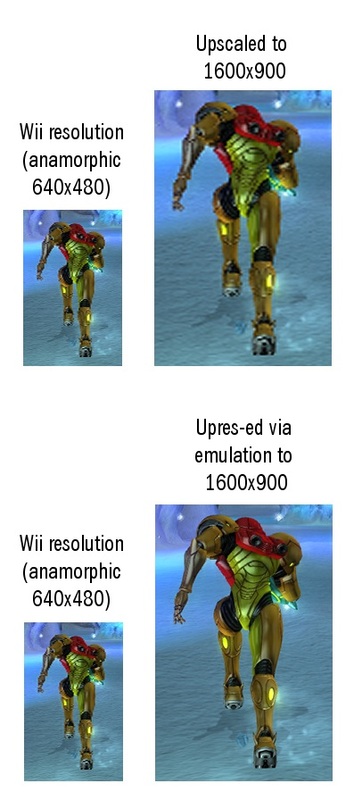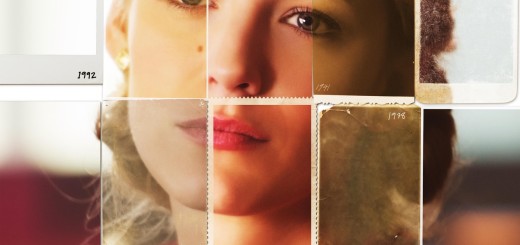Wii-U’s Missed Opportunity – A Picture Worth Many Wii’s
The Nintendo Wii-U launched without much fanfare on Sunday, November the 18th. Â Though there have been many speculations and logical reasons why the Wii-U has so far been a dull whimper of a launch, I have realized a clear opportunity Nintendo missed with their new console: Making their older games “new” again with HD.
Here’s the picture worth 1000 words, courtesy of Neff over from this NeoGAF forum thread:
This image show the clear difference between upscaling and “upres-ing,” meaning the computer does some calculations to smooth out the pixels as it resizes the image.
The top two pictures are what the Wii, running at its native standard definition (SD) best looks like on the left. Â At the top right is what happens when you merely resize the pixels and make them larger to fill a bigger space. Â That is what the Wii-U does to Wii games – it upscales them, redrawing pixels at a much larger size. Â The picture becomes clearer, but the lines become more jagged because pixels are square. Â When they’re small (like on the top left) you don’t notice, but if you blow it up (like on the top right) you REALLY do.
This is not to say the top right isn’t an improvement. Â I’d rather play games upscaled on an HD TV than native on an SD one. Â Again, the image is clearer, colors are typically brighter, and the TVs themselves do some work to clean up the image. Â SD content looks clearer and more jagged on HD screens – but it’s still preferable for things to be clear and boxy than unclear and tricking your eye to assume it’s okay.
What’s crazy is that the picture on the bottom right is not an artist’s interpretation of what an upres-ed game would look like. Â It’s what a real, working Nintendo Wii emulator called Doplin can do, right now, with the existing information in a Wii game.
The day I first discovered emulation was something of a touchstone in my life in technology. Â In chronological order, running my first Apple II program in 1985, using AOL in 1995 and creating my first HTML page in 1995 are the only things prior that were on the same level of astonishment and wonder as when I discovered the emulation scene in 1997. Â It became my passion for years, and I helped to manage a (now defunct) web site dedicated to discussing and working with the various emulation teams. Â The closest thing to it that still exists today is Zophar’s Domain at www.zophar.net.
Imagine discovering, as I did in 1997, that you could run arcade games, NES games like Super Mario Bros. on your PC. Â The emulators transformed your PC into a fully functional software copy of the hardware of those older systems and when combined with the software – in those days, ROM images copied from the cartridges and arcade boards – that you could play them on your computer. Â This wasn’t “Super Mario Bros.” for PC. Â This was the real deal, the game as it originally ran, only right there on your computer.
As happens with Moore’s law, the time it takes for computers to become fast enough to emulate older systems shrinks in time every 18 months. Â The Wii can be emulated at a playable rate under Dolphin – and you can play the real Super Mario Galaxy 2 (a title released in 2010) on your PC.
So back to the crazy part – that image on the bottom right is a PC running Dolphin upres-ing the game. Â It’s performing several enhancements to make the transition smoother as it redraws the pixels. Â These are things that modern PC games take for granted – anti-aliasing, increasing the resolution of the individual textures, improving the shadows and lighting – all of the things it takes to make the difference between what’s at the top right look like what’s on the bottom right.
So why on earth didn’t Nintendo make the Wii-U look better than it did when it plays old Wii games? Â In the end, it comes down to financials. Â It would have been cost-prohibitive to include (the PC’s that can run the games like that cost over $1000 compared to the Wii-U’s $299) and it would deprive them from re-releasing titles at their leisure in “proper” HD remakes, similar to what Sony has been doing with its Playstation2 catalog. Â They would have had to put a lot more horsepower into the Wii-U, and they would have less people clamoring for the ability to play Wii games in “true” HD.
Which leaves Nintendo in a strange place again with hardcore gamers. Â I can play Wii games in ultra-smooth upres-ed emulation on my $1500+ PC if I’m willing to participate in the grey market of using “backups” of games I own, play them on my old Wii which looks pretty bad on my HDTV, or play them upscaled and blocky on the Wii-U.
All you have to do is look at that picture, and you’ll know my answer.



